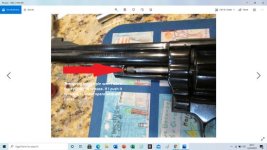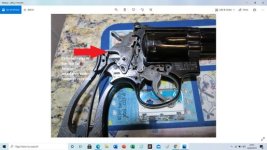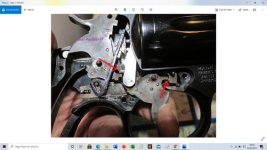SuperSapper
Member
Hi all,
This may belong in the gunsmithing forum...I wasn't sure so feel free to move if needed. Also...those are NOT live rounds in it. They are spent shell casings so the hammer doesn't fall on an empty cylinder.
First, I'm a newbie here and new owner of a 19-3. I usually am a slide gun fan, but this one seems like it will be fun to shoot. .
Only it's having a problem.
First, it's a 19-3, 6 inch barrel, and the previous owner said he removed the target hammer/trigger and replaced it with a Model 15, I believe. The narrower of the bunch (apparently there were three widths of hammer/triggers, so it appears to be the narrowest one).
To insure I did everything correctly, this was the video I watched before touching anything:
[ame]https://www.youtube.com/watch?v=4ujyLn3lHBc[/ame]
To be clear up front, I bought it knowing the problem existed, but I got a pretty good deal on it, and it does function, as I took it to the range.
First, the cylinder does not swing out when the thumb lever is pushed forward. I actually have to tap it out from the right side once I push the thumb release forward. Getting up close and personal with it, I discovered that the spring loaded pin in front of the ejector in the shroud is not going far enough back to release. A small plastic strip artificially pushing the pin back a little and the cylinder releases beautifully. How do I adjust this?
Second issue I noticed is that the thumb release seems to be just a hair too far forward, as it interferes with the hammer moving rearward when pulling the trigger. I discovered this after removing the side plate and attempting to pull the trigger. Another thread suggested some judicious file/stone work to smooth it down a bit, but can the thumb release be adjusted to bring it back enough to clear the hammer?
Lastly, perhaps it's just that it's a M15 hammer on an M19, but there seems to be a bit of binding where the sear contacts the hammer sometimes. Frequently, after pulling the trigger, the trigger does not return to forward position
Some notes:
I noticed the side plate was a bit ajar when I began to remove the screws (previous armorer I do not think did anything in this replacement process correctly) and removed the screws. Following the video one step at a time, I removed everthing, cleaned, lightly oiled, and replaced exactly as seen in the video (all the parts look the same).
Appreciate any help from the smiths out there
Mark
This may belong in the gunsmithing forum...I wasn't sure so feel free to move if needed. Also...those are NOT live rounds in it. They are spent shell casings so the hammer doesn't fall on an empty cylinder.
First, I'm a newbie here and new owner of a 19-3. I usually am a slide gun fan, but this one seems like it will be fun to shoot. .
Only it's having a problem.
First, it's a 19-3, 6 inch barrel, and the previous owner said he removed the target hammer/trigger and replaced it with a Model 15, I believe. The narrower of the bunch (apparently there were three widths of hammer/triggers, so it appears to be the narrowest one).
To insure I did everything correctly, this was the video I watched before touching anything:
[ame]https://www.youtube.com/watch?v=4ujyLn3lHBc[/ame]
To be clear up front, I bought it knowing the problem existed, but I got a pretty good deal on it, and it does function, as I took it to the range.
First, the cylinder does not swing out when the thumb lever is pushed forward. I actually have to tap it out from the right side once I push the thumb release forward. Getting up close and personal with it, I discovered that the spring loaded pin in front of the ejector in the shroud is not going far enough back to release. A small plastic strip artificially pushing the pin back a little and the cylinder releases beautifully. How do I adjust this?
Second issue I noticed is that the thumb release seems to be just a hair too far forward, as it interferes with the hammer moving rearward when pulling the trigger. I discovered this after removing the side plate and attempting to pull the trigger. Another thread suggested some judicious file/stone work to smooth it down a bit, but can the thumb release be adjusted to bring it back enough to clear the hammer?
Lastly, perhaps it's just that it's a M15 hammer on an M19, but there seems to be a bit of binding where the sear contacts the hammer sometimes. Frequently, after pulling the trigger, the trigger does not return to forward position
Some notes:
I noticed the side plate was a bit ajar when I began to remove the screws (previous armorer I do not think did anything in this replacement process correctly) and removed the screws. Following the video one step at a time, I removed everthing, cleaned, lightly oiled, and replaced exactly as seen in the video (all the parts look the same).
Appreciate any help from the smiths out there
Mark
Attachments
Last edited:






